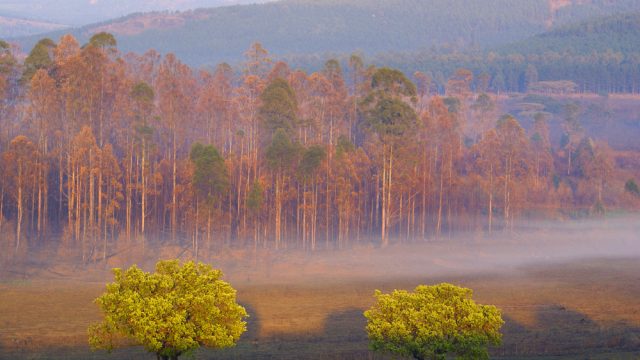From white water rafting to hut-to-hut hiking and safaris in search of rare black rhino, the east and southern sides of Swaziland are great places to go off the grid. In the shadow of the Lebombo Mountains, the Eastern Swaziland lowveld landscape is filled with sugar plantations and sprinkled with four of the country’s five wildlife reserves. It is also an easy drive from the Mozambique border, and it can be easily visited on a day trip from Maputo, which is less than 100 km away. While southern Swaziland, on the border with South Africa’s KwaZulu-Natal province, is home to kilometers upon kilometers of untouched natural forests and a stunning gorge.
Here are five wild Swaziland experiences.
1. Mkhaya Game Reserve
You cannot drive yourself into this top-notch private reserve, which is named for the knobthorn trees that are plentiful here. It must be pre-booked and you’ll need to arrive at the nearby hamlet of Phuzumoya at a pre-determined pick-up time. Mkhaya was originally established to protect the pure Nguni breed of cattle in 1979, but today most guests visit to see rhino. It brags that it is the best place in Africa to see rhino, and I can’t really argue with their claim, as I’ve never spotted so many of these magnificent horned creatures on one safari as I did at Mkhaya. Best of all, the reserve is not only home to the more prevalent white rhino, it also has a healthy population of the rare, endangered black rhino. In the 1990s, black rhinos were nearly extinct, but thanks to conservation efforts their numbers have risen to around 5,050 in sub-Saharan Africa today – by comparison there are some 20,000 white rhino found on the continent.
Check into Stone Camp, which has a mod-meets-colonial feel in luxurious bush accommodations comprised of semi-open thatch and stone cottages. The all-inclusive rate includes meals and wildlife drives as well as walking safaris.
2. Great Usutu River
For a shot of adrenaline, a whitewater rafting trip down the Great Usutu (also known as the Lusutfu) River is a Swaziland must-do. Swazi Trails organizes half- and full-day trips that include lunch and transport down the Bulungu Gorge section of the river, where a set of mild to white-knuckle rapids await. The wildest rapid is a Class IV, which while exhilarating, can be tackled by first time rafters with a sense of adventure. When water levels are low, and the white water slightly sluggish, guides add an extra rush by offering clients the opportunity to jump off cliffs into the river or rappel down them.
3. Ngwempisi Gorge
In Southern Swaziland, about 30 km from the Malkerns Valley, the Ngwempisi Gorge is one of the last untouched natural strongholds in Swaziland. A land of rock and river and virgin natural forests, it’s a great place to get lost. I like the 33-km-long Ngwempisi Hiking Trail, which is managed by the local community and crosses the Ntfungula Hills on the Mankayane-Vlelzizweni road and is usually done in three days – there are two distinct hut stops to spend the nights along the way. It is recommended that you take a guide along. Inquire at Horseshoe Estate B&B by the trail’s start.
4. Shewula Mountain Camp
Located 37 km northeast of the prim, colonial-style sugar company town of Simunye is Shewula Nature Reserve. The camp inside, Shewula Mountain Camp, is a community- owned ecotourism initiative — Swaziland’s first — in the Lebombo Mountains. Sitting at the top of a mountain with fantastic panoramic views, it offers basic accommodation in dorms or rustic rondavel huts (most don’t have private baths), but it is a good spot to really escape for a night. If you have a tent, there is also camping, and you’ll be helping out the local community. Sign up for one of the guided nature walks that take you to nearby villages for a local cultural experience. All meals can also be arranged – but must be booked in advance.
5. Hlane Royal National Park
Hlane Royal National Park, 7 km south of Simunye, is Swaziland’s largest protected area, home to all the major animals including lions, cheetahs, leopards, white rhinos and elephants, and it offers a much more low-key wildlife viewing experience than many South African parks.
Because the big cats are confined to a special enclosure that can only be visited on park wildlife drives at sunrise and sunset, there are opportunities to explore this park outside of a vehicle. If you’re feeling gutsy, join a guided walking tour with an armed ranger, as these allow you to get pretty close to elephant and rhinos – it can be slightly intimidating, I must admit. You can also explore certain areas by mountain bike, which can be rented in the park. It’s pretty cool to see the smaller animals from between the handles of a cycle.

